News
Here you can keep up to date with the latest news from Highgate Cemetery. Or, to hear about it as it happens, you can subscribe to our e-newsletter! Subscribe
OPEN DAILY 10AM - 4PM November to March (EXCEPT CHRISTMAS DAY AND BOXING DAY) CARD PAYMENTS ONLY.
Here you can keep up to date with the latest news from Highgate Cemetery. Or, to hear about it as it happens, you can subscribe to our e-newsletter! Subscribe
Unlocking Highgate Cemetery launches today thanks to a major award from The National Lottery Heritage Fund. This seven-year, £18 million project will ensure Highgate Cemetery remains an active burial ground and a vital sanctuary for heritage, nature and community.
Read on to find out more and sign up to our newsletter to stay in touch.
For almost two centuries, people have enjoyed the dramatic architecture and sinuous paths of this extraordinary funerary landscape. Today, time and climate change have exposed the fragility of the historic structures and access to some areas is now difficult or closed. The most urgent needs include conservation of the Grade I-listed Egyptian Avenue and Grade II*-listed Terrace Catacombs, restoring access to expansive views of London and re-opening the grand West Carriage Drive. We will also open the Dissenters’ Chapel as a public space to explore 200 years of human stories.
Highgate Cemetery is a haven for life, from trees and plants to a variety of insects, birds and mammals, including a rare cave spider. Over time, the effects of climate change and an increasing monoculture of self-seeded Ash trees and a blight of Ash dieback have degraded this rich habitat. We will remove dangerous and diseased trees, restoring biodiversity with climate-resilient planting and improved drainage. Above all, we will protect the special character of Highgate Cemetery, where nature is inextricably entwined with stone.
Community is at the heart of Highgate Cemetery, from grave owners and visitors to the Friends and volunteers who for the last 50 years have battled to save the site from dereliction. As part of Unlocking Highgate Cemetery, we will partner with local organisations to develop oracy skills for school groups, vocational training in landscape management, as well as free online learning resources on universal themes such as grief, memory or celebrity. Our new interpretation plan will expand the range of stories we tell, reflecting the huge range of our heritage and welcoming a greater diversity of people.
This £18m project needs your support. In addition to the Heritage Fund, we are allocating our reserves to this vital work. However, we must still raise £1.2 million to unlock Highgate Cemetery for future generations. Contact us to find out how you can help or make a donation here. Thank you.
Stay in touch by signing up to our newsletter
The Conversation Continues: We Are Still Listening is a 40-minute immersive soundscape from artist Trevor Mathison that offers a re-examination of the lives and histories of those laid to rest at Highgate Cemetery in the context of contemporary anti-racism movements. The commission honours the memory and ongoing impact on contemporary national debates of cultural studies pioneer Stuart Hall, who is buried at the cemetery. Audiences are invited to listen to the soundscape on headphones as they follow their own pathway through Highgate Cemetery’s beautifully conserved landscape of monuments, buildings, flora and fauna.
Trevor Mathison developed The Conversation Continues: We Are Still Listening by exploring the legacy of Stuart Hall (1932 – 2014) and his arrival in the UK from Jamaica in 1951 and taking a historical look at Highgate Cemetery: how it came into being, the radical thinkers buried there, and its botanical meditative landscape. The piece imagines those that are resting – philosophers, artists, writers from different periods – coming together to expand on their lives’ work and debate with each other. Mathison has incorporated field recordings from the Highgate Cemetery and its surrounding areas, as well as audio excerpts from Stuart Hall’s 2004 lecture ‘Through the Prism of Intellectual Life’, text from Hall’s posthumous memoir ‘Familiar Stranger’ spoken by actor Joseph Black and poetry written and performed by Selina Nwulu.
Speaking on the commission, Trevor Mathison said: “I am fascinated by the number of individuals buried in the cemetery who have contributed so greatly to our own realities and in various different ways; from scientists, philosophers, writers, painters, academics and many more. First among them for me, is Stuart Hall who was one of the most important social and cultural thinkers of our time. I feel the need to keep them close, to acknowledge their work and think about how their ideas and questions continue on through our own present-day debates. I have also been drawn to the plants that grow alongside the graves in Highgate Cemetery, imagining how voices might permeate, connect and continue to flourish through the rich layers of its natural landscape. My hope is that the soundscape provides a meditative space for the listener to relate back to the cemetery, reflect on Stuart Hall’s legacy and in this way, to consider the community and dialogue resting there, with all its multiple, active connections that we are being invited into.”
STUART HALL AND HIGHGATE CEMETERY
Professor Stuart Hall was a member of the ‘Windrush Generation’ who arrived in Britain from Jamaica in 1951. He became a leading figure in Britain’s radical tradition, whose work transformed the nature of public conversations around culture, race, and identity at a pivotal time of immigration and social change. He was a prolific writer and a deeply committed teacher with a firm belief in collaborative projects, a desire to communicate and an expansive range of interests which continue to have vitality and relevance to those hoping and working for change.
Unlike many of the Windrush generation, Stuart did not wish to return ‘home’ to Jamaica on his death. Despite a long and uneasy relationship to belonging in Britain, he imagined he would be in good company at Highgate Cemetery, settled amongst a community of Left intellectuals – Karl Marx, Eric Hobsbawm, Raphael Samuel, Claudia Jones – and close enough to his North West London home for it to feel familiar. Here, he is settled, in the company of friends and others who have contributed in critical and imaginative ways to Britain’s cultural and political landscape. Like many visitors to the Highgate Cemetery, Stuart Hall’s family and friends have developed a living relationship with the site which resonates with the Stuart Hall Foundation’s interest in bringing the past, present and future into a meaningful dialogue with one another.
Becky Hall, a Stuart Hall Foundation trustee and daughter of Stuart Hall, said: “The origins of this project lie in a conversation on love and loss traced along the much-loved pathways of Highgate Cemetery and framed by the shifting seasonal hues of a cool, June day. A pinch of mischief was involved, as well as generosity, graft and collaboration – all vital ingredients for public, political and personal work that would have pleased Stuart greatly. It is with gratitude from his family and the Stuart Hall Foundation that we celebrate Trevor Mathison’s truly special capacity to bring the wonder of sound and space alive in conversation and welcome his public invitation to listen.”
The Conversation Continues: We Are Still Listening was commissioned by the Stuart Hall Foundation in partnership with Highgate Cemetery and LUX, and with funding from Arts Council England and The Elephant Trust.
Ian Dungavell, Chief Executive of Highgate Cemetery, said: “Highgate Cemetery is thrilled to be a part of Trevor Mathison’s new work, The Conversation Continues, which responds to the community of Left intellectuals buried here and the Cemetery’s wonderfully romantic landscape. As the UK’s most famous cemetery and the final home of thinkers from around the world, Highgate Cemetery is the perfect setting in which to reflect on Stuart Hall’s legacy of debates around culture, race and identity. Cemeteries are the natural place for such reflections.”
HOW TO LISTEN
The piece is available for the first time from Saturday 11th June 2022 as part of Highgate Festival in London (11th – 19th June). It is recommended audiences experience the soundscape from within Highgate Cemetery as intended by the artist Trevor Mathison.
For more information on how to listen, visit the Stuart Hall Foundation’s website. Buy your cemetery entrance tickets at highgatecemetery.org/visit/stuart-hall-foundation
For those unable to visit the cemetery in person, a video version will be released online on Monday 20 June.
ACCOMPANYING PROGRAMME
The Conversation Continues: We Are Still Listening will be accompanied by a programme of special events and screenings in June including:
An evening preview event at Highgate Cemetery Chapel on Thursday 9 June featuring a conversation between Trevor Mathison and Aasiya Lodhi, with a reading by actor Joseph Black of extracts from ‘Familiar Stranger’. As part of the event, the conversation as well as the commission’s video version will be livestreamed to registered online attendees via Zoom.
A video accompaniment to the soundscape created by Trevor Mathison made available online for a limited time period from June 20th for remote audiences who are unable to access Highgate Cemetery in person.
A unique performance event, Midsummer Night, with Trevor Mathison at LUX on Friday 24th June that expands upon where The Conversation Continues: We Are Still Listening began, through tonal poetic movements, reflective visuals from Highgate Cemetery, and experimental spoken word.
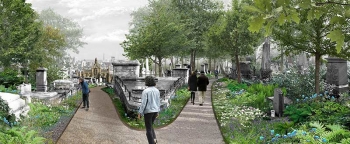

World-famous Highgate Cemetery, resting place of many well-known people from Karl Marx to Lucian Freud, today announced the two winning teams in its Landscape and Architectural Projects competitions.
The competitions, which were launched last November, attracted practices with some of the most creative and internationally recognised expertise in their fields. Highgate Cemetery is delighted to announce that the winner of the Landscape Competition is Gustafson Porter + Bowman, and the winner of the Architectural Projects Competition is Hopkins Architects.
The teams will assist the Cemetery in preparing a new 25-year masterplan for the site, which will secure its future and ensure it remains a historic, and sustainable, 21st century cemetery. It will include provision of modern facilities for those looking after the site as well as improving it for grave owners and visitors.
Studio Voltaire has announced a major new site–specific sculpture commission by internationally celebrated artist Phyllida Barlow at Highgate Cemetery, London. The commission will be staged in the open–air courtyard of the West Cemetery, presenting
a special opportunity to encounter ambitious new work by this leading artist within an extraordinary and historic site.
The large–scale commission, act, reaches up to five meters in height. A tower of fabric wrapped poles are enclosed within a commanding structure of sombre, concrete screed panels flecked with colourful paint. Knitted together, these bulwarks of material create an imposing, sepulchral form. However, their exposed supporting frameworks reveal stage–set properties, undermining any initial appearance of monumentality.
Barlow’s structures of stacked, bound and balanced materials have an imposing physical presence and yet often appear at the edge of collapse. Her assemblages are formed of inexpensive industrial or everyday materials – cardboard, fabric, timber, polystyrene, plaster, scrim and cement – painted in vibrant colours, the seams of their construction at times left visible. Tensions in Barlow’s work between transformation, entropy and precarity resonate strongly with the chosen site’s character and surrounding monuments. Her commission is both a dramatic and contemplative response to the elaborate, melancholic funerary architecture of the cemetery, and will bring audiences into unexpected dialogues with a landmark site.
Barlow’s work sits within a site of historic importance and is framed by the courtyard’s impressive colonnade. Famed for its special atmosphere, the cemetery’s sinuous paths wind up a steep, wooded hill and ivy–clad memorials, forming a secluded and evocative landscape. The West Cemetery is home to the most impressive architectural features of Highgate Cemetery, including the Egyptian Avenue, Circle of Lebanon and Terrace Catacombs.
This commission is presented in partnership with Highgate Cemetery. Dr Ian Dungavell, Chief Executive of Highgate Cemetery, said: "Cemeteries were the outdoor sculpture parks of the nineteenth century. Visitors would be inspired by the achievements of those who had gone before them, and they would be improved by looking at the artistic monuments and poetic inscriptions. Masons were sent to study antique sculpture in the British Museum. Barlow's sculpture will be in the courtyard at Highgate Cemetery, mediating between the urban buzz outside and the peaceful tranquillity of the burial landscape. Its themes are entirely appropriate to the setting. We hope it will inspire visitors in the same way as the nineteenth century monuments, and inculcate a frame of mind conducive to cemetery visiting."
In 2010, Studio Voltaire commissioned BLUFF, a significant exhibition of Barlow’s work which played an important role in raising the artist’s international profile. This new exhibition, a decade later, celebrates a pivotal commission within Studio Voltaire’s history, and reflects their track record of supporting artists at key stages in their careers. Barlow is a renowned contemporary artist, whose work has been the subject of major solo exhibitions at Haus der Kunst, Munich (2021), The Royal Academy of Arts, London (2019), Nasher Sculpture Center, Dallas (2015) and Tate Britain, London (2014). In 2017, she represented Britain at the Venice Biennale.
act was commissioned as part of Studio Voltaire elsewhere, a series of commissions taking place offsite whilst undertaking The Studio Voltaire Capital Project.
act is supported by Arts Council England, Bloomberg Philanthropies and Art Fund.
Edition production was kindly supported by Hauser & Wirth.
Highgate Cemetery, resting place of many well-known people from Karl Marx to Lucian Freud, is launching two open competitions to ensure the captivating site is conserved and enhanced for future generations.
Whilst the Cemetery retains its enchanting atmosphere, its monuments are under threat from long-term decay and maturing self-seeded trees. The trees themselves are increasingly stressed by climate change and afflicted by new pests and diseases. More extreme weather is eroding gravel paths and overwhelming the historic drainage systems. All this is undermining the historic landscape design and reducing biodiversity. Added to concerns related to sustainability and the climate emergency, it is clear that the Cemetery needs to find a way to adapt to the new demands of the twenty-first century.
That is why the Friends of Highgate Cemetery Trust is today launching two open competitions. The first is to find the best practitioners in landscape design to develop a landscape masterplan. The second is to find an architect-led multidisciplinary design team to investigate projects to preserve and enhance the historic structures and improve facilities for staff and visitors. A comprehensive Conservation Plan completed in 2019 forms the bedrock of these competitions.
Martin Adeney, Chair of the Friends of Highgate Cemetery Trust, said: ‘We will be working with the local community, cemetery volunteers and experts so that the trees, paths, monuments and buildings will be better looked after, the Cemetery will continue to function as an active burial ground and visiting will be easier and more rewarding.
‘This is important because Highgate is still a working cemetery with over 170,000 people buried here and in more usual times welcomes over 100,000 visitors a year from all over the world.
‘Having saved the Cemetery from dereliction in the 1970s, and secured the major monuments, the Friends of Highgate Cemetery Trust is now looking at how this world-famous resting place of so many distinguished people can be conserved and enhanced for future generations.
‘We are seeking the most imaginative practitioners to work with us in developing a new landscape vision that can sensitively respond to the history and character of Highgate Cemetery. We will ensure that the Cemetery remains the place of enchantment which so many people value, whose carefully-tended natural environment provides sanctuary for those buried here and their loved ones, as well as the thousands who visit.’
Jane Findlay, President of the Landscape Institute said ‘As custodians of such a significant landscape site, by launching these competitions, the Friends of Highgate Cemetery Trust has taken the important step in ensuring it will be fit for the twenty-first century.
‘This is not a short-term undertaking, but it is an important one. The landscape masterplan will guide the development of the Cemetery for the next twenty-five years, so it is important that we attract the best talents in landscape design and architecture for this world-renowned cemetery. As the chartered body for the landscape profession, we are delighted to have been able to use our expertise in the sector to create this landscape competition.’
HOW THE COMPETITIONS WILL WORK
The two competitions are open to landscape architects and to architects respectively, and multi-disciplinary landscape, architecture and design practices may choose to enter both competitions.
The competitions will run simultaneously as the landscape, buildings and facilities need to be considered holistically.
Highgate Cemetery is looking for the best team to produce a landscape masterplan to guide the development of the Cemetery over the next twenty-five years. The plan must preserve and enhance the qualities for which the Cemetery has been appreciated over generations while enabling it to meet the varied demands and expectations of the twenty-first century.
Timings: Stage 1 entries by 13 January 2021. Stage 2 will run from 1 February to 24 March 2021. Site visits will be offered in week commencing 7 December 2020.
Please visit highgatecemetery.org/competitions for more information.
Highgate Cemetery is looking for an architect-led multidisciplinary team to consider how to conserve historic structures and improve facilities at the Cemetery for visitors and staff. The competition is open to architects registered with the Architects Registration Board in the UK or the equivalent in their home country.
The successful team will be talented enough to produce exceptional quality of design and respectful enough for this to sit happily within the Grade 1 registered landscape and adjacent to the many listed structures.
Timings: Stage 1 entries by 20 January 2021. Stage 2 will run from 1 February to 24 March 2021. Site visits will be offered in week commencing 7 December 2020.
Please visit highgatecemetery.org/competitions for more information.
Winners of both competitions will be announced in May 2021.
A short film about Highgate Cemetery and the people that make it what is can be found at highgatecemetery.org/competitions
Ends -
For further information, images or interviews please contact Adela Cragg or Morag Wood at the Culture Communications Collective on:
T: 07532 685 614 E: adela@culturecommscollective.com or
T: 07976 081 044 E: morag@culturecommscollective.com
Notes to editors:
Highgate Cemetery, opened in 1839, was set up by a private company. From the outset it welcomed visitors captivated by the beauty of its scenery as well as those who came to remember the dead. They would muse on the meaning of the inscriptions, admire the art of the monuments and no doubt reflect on their own mortality. But it was a victim of its own success: as space ran out it became uneconomical to run and by the 1970s was virtually abandoned by its founders.
Today, Highgate Cemetery is owned and run by the Friends of Highgate Cemetery Trust, who saved it from dereliction in 1975. It is a registered charity and all income is devoted to the maintenance and enhancement of the site for the public benefit.
It is the resting place of many well-known people, from Karl Marx to Lucian Freud, George Eliot to Radclyffe Hall, Michael Faraday to Beryl Bainbridge, as well as 170,000 other Londoners.
The Highgate Cemetery Landscape Competition is being managed and administered by Artelia UK and the Landscape Institute on behalf of Highgate Cemetery Limited, which is the operating subsidiary of the Friends of Highgate Cemetery Trust.
The Highgate Cemetery Architectural Projects Competition is also being managed and administered by Artelia UK.
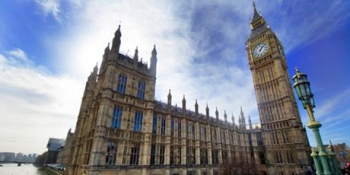
For more on the Highgate Cemetery Bill, see our page on Renewal
IN PARLIAMENT : SESSION 2019–20
NOTICE IS HEREBY GIVEN that application has been made to Parliament by the Friends of Highgate Cemetery Trust (“the Trust”) for leave to introduce a Bill in the new Session under the above name or short title.
The purposes of the Bill are to confer powers on the Trust, who is the burial authority responsible for Highgate Cemetery (“the cemetery”). These powers would authorise the Trust to extinguish rights of burial in grave spaces where such a right has not been exercised for at least 75 years from the last burial or if there has been no burial, from the date of the grant of that right. Where such rights are extinguished, the Bill also authorises the Trust to disturb and reinter human remains in graves in the cemetery in order to increase the space for further interments in such graves and for the improvement of the cemetery. The powers would also enable the Trust to use appropriately or remove altogether from the cemetery any memorials on such graves. The same powers are already available to local authorities in London in respect of cemeteries for which they are responsible. The powers would enable the Trust, following consultation with or at the request of Historic England and the London Borough of Camden, to designate “protected graves”. If a grave is protected in this way, then the powers to extinguish burial rights and disturb remains can only be exercised with the agreement of Historic England and the London Borough of Camden. The Bill also makes provision for the repeal of historic and redundant legislation pertaining to the London Cemetery Company, which was the statutory company originally responsible for the cemetery, together with other ancillary provisions.
Click to download a copy of the Highgate Cemetery Bill.
On and after 4 December 2019 a copy of the Bill may be inspected and copies of it obtained at the price of £3 each at the offices of:
Highgate Cemetery
Swain’s Lane
London N6 6PJ
Mondays to Fridays: 10:00 to 16:00
Saturdays, Sundays and Bank Holidays:
By arrangement (Telephone: 020 8340 1834)
BDB Pitmans LLP
50 Broadway, Westminster,
London SW1H 0BL
Mondays to Fridays: 09:30 to 17:30
Saturdays, Sundays, 27 December 2019 and Bank Holidays: Closed
Objection to the Bill may be made by depositing a Petition against it in the Office of the Clerk of the Parliaments, if the Bill is introduced in the House of Lords, or in the Private Bill Office of the House of Commons, if the Bill is introduced in that House. The latest date for the deposit of such a Petition in the First House will be 30 January 2020 if the Bill originates in the House of Commons, or 6 February 2020 if it originates in the House of Lords. The latest date for deposit of such a Petition in the Second House will be the tenth day after the first reading of the Bill in that House or, if the House is not sitting on that day, on the next day on which that House sits.
Further information regarding petitioning may be found on the Parliament’s webpage at: https://www.parliament.uk/about/how/laws/bills/private/privatebillpetition/ or by contacting either—
the Office of the Clerk of the Parliaments, House of Lords:
E-mail: hlprivatebills@parliament.uk
Telephone: 020 7219 3231
the Private Bill Office of the House of Commons:
E-mail: prbohoc@parliament.uk
Telephone: 020 7219 6008
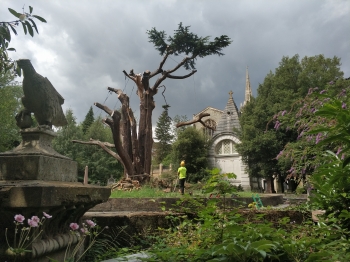

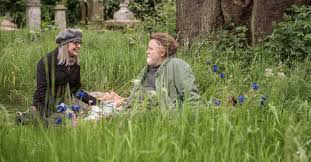
Nobody knows how old was the Cedar of Lebanon at the heart of Highgate Cemetery, but the guess is at least 250 years. It became a stunning landscape feature when the Cemetery was laid out around it in 1837-8.
But unfortunately this grand old tree has reached the end of its time and has had to be removed. The tree experts rated it as ‘high risk’, having a high potential of catastrophic failure and posing a risk to both persons and property. We were advised to make it safe immediately.
"We didn't want to believe the report," said Dr Ian Dungavell, Chief Executive of the Friends of Highgate Cemetery Trust. "Although it had suffered from snow and lightning, it was by far the most important tree in the Cemetery, and we had been doing everything to keep it well."
However, significant decay had been detected in each of the three main stems. And one of them had a fungus, Laetiporus sulphureus, which degrades the lignin within the timber and causes brown cubical rot, making it prone to brittle and unpredictable failure. Worse, the southern of two fused vertical twin-stems, which was structurally supporting the south-western portion of the crown (about half of the entire crown), was predominantly dead.
"We went through it very carefully, stem-by-stem, but the conclusions were inescapable," he said. "Around 25,000 people walk beneath that tree every year. And it sits on top of a large Grade 1-listed structure, the 'Lebanon Catacombs', which themselves contain quite a number of burials in fragile, lead-lined coffins. A collapse would have been horrific."
"The hunt is now on to find a replacement tree, as big as it can be, which can fill that spot for another two hundred years or more."
Diane Keaton and Brendan Gleeson were seen picnicking beneath the Cedar of Lebanon in the film Hampstead (2017).

This is the Conservation Plan for Highgate Cemetery. (26MB pdf) The plan has been prepared by a leading multi-disciplinary consultancy, Alan Baxter Ltd, and so it benefits from their considerable knowledge and experience. We consulted members, volunteers and the public about what the plan might include and the plan responds to that consultation. The resulting document sets out the history and significance of this special place, and explains how we propose to look after it in the future.
There are three main strands to the proposals:
Trees, monuments and buildings will be better looked after
Trees of the most suitable species in the most suitable places and in good health will make it easier, and safer, to appreciate the quality of our historic landscape. Furthermore, not only will they be less likely to damage memorials, this will be better for biodiversity too. In addition, we would like to reveal many of the memorials currently hidden by ivy, and to restore the more important of them so that future generations will be able to appreciate them as we do. We would also like to return our chapel and its setting to its proper appearance, especially by reinstating the chapel’s lost cupola, pinnacles and finials.
The cemetery will continue to function as an active burial ground
A closed cemetery is a dead cemetery, so we will investigate how we can continue to provide for the burial needs of current and future generations. This could involve reclaiming grave space which has never been used, or re-using graves that are no longer wanted, or creating additional spaces for cremated remains in columbaria and attractive garden settings. All of this can be knitted in carefully and respectfully to our wonderful historic environment.
Visiting will be easier, and more rewarding
We are keen to improve the visitor experience, from sharing our acquired knowledge of the Cemetery and who is buried here, to helping people find their way around better on site. We propose to explore the opening of the West Cemetery for free-flow visitors in addition to our excellent guided tours. We would also like to provide better displays and interpretive material, as well as the creature comforts everyone expects nowadays: some food, drink and adequate toilets.
All this can be done while preserving the essential character of the place. We believe that evolution rather than revolution is the way forward. The next step will be to develop an implementation plan. This will set out how we intend to prioritise and deliver the actions set out in the conservation plan. This plan will be determined by a number of factors, including our ability to secure the necessary funding. We anticipate that we may also need help from the National Lottery Heritage Fund and private donors, as well as a new Act of Parliament if we are to manage our burial space more effectively.
Highgate Cemetery is one of the world’s finest garden cemeteries, and the policies in this Conservation Plan are intended to help keep it that way.
ADAM COOKE
Chair, Friends of Highgate Cemetery Trust
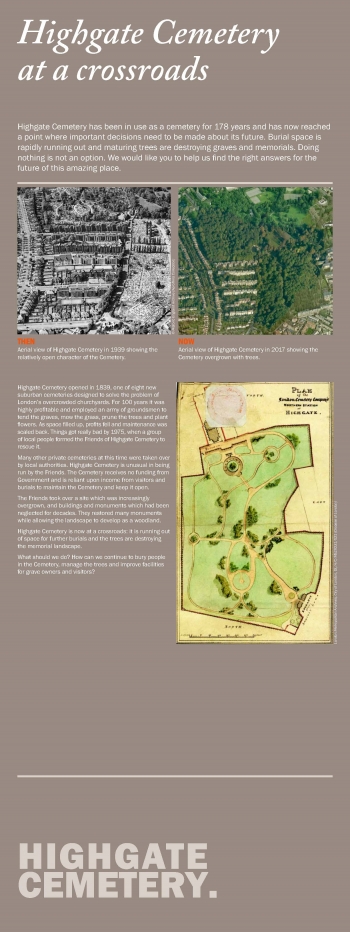
Highgate Cemetery has been in use as a cemetery for 179 years and has now reached a point where important decisions need to be made about its future. Burial space is running out and maturing trees are destroying graves and memorials. Doing nothing is not an option.
We have commissioned a conservation plan to guide the future of the cemetery. The purpose of a conservation plan is to make sure that when you make changes to a place, these changes should not only maintain but enhance what is special about it. The conservation plan should be completed by the end of this year and there will be a public consultation on the final draft plan before it is adopted.
We have put these documents online so that you can see some of the process which has informed our thinking. But please do bear in mind that the drafts are just that. There will be a formal opportunity to comment on the full conservation plan, but should you wish to make any comments on these documents, please email info@highgatecemetery.org.
Our consultants are now working on the draft full conservation plan. It will contain the policies which will guide our management of the Cemetery into the future.
We will post the draft on this website in June and invite comments on it. Once those comments have been reviewed and any required changes incorporated, the conservation plan will be adopted as policy by the trustees.
The next stage will be implementing the policies set out in the plan.
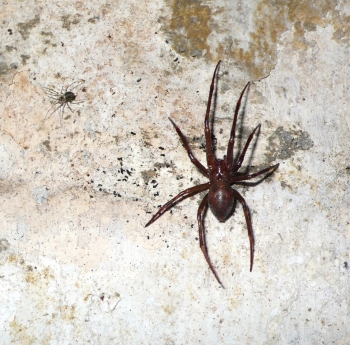
Meta bourneti at home in Highgate Cemetery
A large, rare spider has been recorded for the first time in London — deep in tombs at Highgate Cemetery. As part of the Wild London Inclusive London project, staff at London Wildlife Trust have been working with the staff and local community of Highgate Cemetery since last summer. During a bat survey in December, Trust staff came across a population of large spiders in the vaults of the Egyptian Avenue at the Cemetery.
Interestingly, these orb weavers are the species Meta bourneti, the rarer of two species of Meta (Britain’s largest orb weavers). The identity of the spider was confirmed by Edward Milner, Spider Recorder at the London Natural History Society — and it is the very first record of the species in London!
Meta bourneti is particularly fascinating because, due to its origins as a cave-dweller (also known as a cave spider), it requires total darkness. Even an outdoor night time environment is too bright for it, so the spiders never leave the tombs. A sealed vault, on the other hand, provides a perfect breeding ground. Most of these vaults - walk-in tombs designed to house around four coffins — have not been opened for several years. And, because the structures date from the late 1830s, it’s quite possible the spiders discovered have lived in the tombs for at least 150 years without being detected.
The find is made even more exciting by the spider’s large size. Most new spider records are for tiny species, but Meta bourneti measures over 30mm in diameter with leg-span included. Meta spiders are amongst the largest spiders found in Britain. In addition, the size of the population at Highgate Cemetery is substantial: A very rough initial estimate puts the number of adults at as many as a hundred. More research will now be carried out.
Tony Canning, London Wildlife Trust Community Outreach Officer for Camden and lead on the project, commented: “The discovery of this important spider population in the heart of London shows just how valuable cemeteries such as Highgate can be in providing refuges for wildlife.”
During the various species surveys recently undertaken at Highgate Cemetery — and with the help of several expert specialists — London Wildlife Trust staff have discovered 227 species previously unrecorded at the site on London’s environmental records centre, Greenspace Information for Greater London (GiGL).
Meta spiders prey on small insects and woodlice. The females produce teardrop-shaped eggsacs, which hang suspended on a silk thread from the roof of their dwelling. When the spiderlings first emerge they are attracted to light, unlike the adults which are strongly repelled by light. This helps the spiderlings find new areas to colonise.
Meta bourneti also need constant temperatures and high levels of humidity. Elsewhere in the UK, these spiders can be found in sewers, old cellars and abandoned railway tunnels.
Thanks to the London Wildlife Trust.
© 2024 Friends of Highgate Cemetery Trust. Registered Charity No. 1058392. Company Limited by Guarantee. Registered in England No. 3157806. Registered office Swain’s Lane, London N6 6PJ